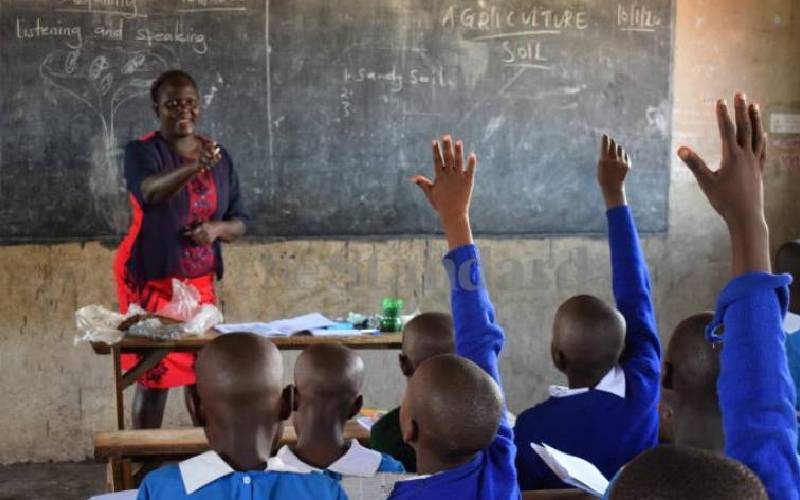
Evaline Ogesa, a teacher at Shauri Yako Primary school in Homa Bay, teaches Grade Four pupils agriculture, on January 10, 2020. [James Omoro, Standard]
A barrier to learning is anything that stands in the way of a child being able to learn effectively.
Learning barriers can be physical, mental, emotional, cultural, or social elements that get in the way of a student achieving their learning goals.
Learning disabilities affect how people understand information, communicate, or learn new skills, and include difficulty reading, difficulty writing, and difficulty with mathematics.
A child with a disability will experience that disability as an intrinsic barrier to learning and will require varying levels of support to accommodate their disability to reach their full academic potential. Barriers to learning are not limited to intrinsic.
They can also be societal/environmental barriers. For example, extreme poverty, abuse, or neglect will all act as barriers to a child’s learning.
Motivation or “availability to learn”
A student’s availability to learn depends largely on their motivation. Our desire to achieve results and improve our knowledge, regardless of the material being studied, is one of the most important factors in our ability to learn.
According to Maslow’s Hierarchy of Needs, there are essentials needs that we seek to learn. Self-actualisation appears at the top of this pyramid. A lack of motivation is a major barrier to students’ learning and without a desire to succeed, students often end up doing the bare minimum amount of work in the classroom.
A lack of motivation can often result in students going through the motions of learning and not retaining information. Instructors should be aware of the possible motivation behind their students’ enrolment and retention. Then they can better shape the instructional materials to catch learners’ attention.
Motivation is perhaps the most important requirement for the achievement of the targets of teaching/learning.
Social and cultural barriers
A child’s ability to interact socially with their peers significantly impacts how they progress in the classroom. The very act of learning in a classroom environment involves interacting with other students, talking through problems, and finding solutions.
Why interaction is important: In today’s classroom with an average pupil-to-teacher ratio of 77 to 1 (the highest which is in Turkana county, according to 2020 UNICEF statistics), peer-to-peer learning in schools is important now more than ever.
Discussing lessons with other students helps pupils realise their strengths and weaknesses and enables them to improve their knowledge gaps, learning directly from their classmates.
Students who have poor social skills often fall behind in their learning as they aren’t able to communicate as effectively as others. Of course, not all types of learning require students to be social, but in the early years, in particular, the ability to listen, respond, and empathize with other people are all important learning skills.
How environment can shape social skills: The culture in which a child grows up can also have a bearing on their ability to learn. Looking at Maslow’s table, ‘belonging’ is one of the most essential learning needs.
The relationships that we form with our parents, friends, and teachers all feed into our ability to learn. As humans, we are hugely influenced by the people around us and during our first five years, our principal influencers are our parents or guardians.
Our parents’ beliefs and cultures can heavily influence how we learn as students. For example, if a student has grown up in a household where mathematical subjects are given more weight than languages, that student may have a cultural barrier when it comes to learning subjects like English.
Emotional factors affect learning
A student’s self-esteem plays an important role in their ability to learn. The encouragement that we receive from our teachers, parents, and friends plays an important role in our emotional learning. If a student adopts a mindset of ‘always trying their best and learning from past failures, they’ll generally have a positive outlook on their ability to learn.
On the other hand, if a student’s internal voice is always telling them that they’re not good enough or that there’s no point in even trying, they’re more likely to underachieve in school.
A student’s emotional well-being majorly impacts their ability to do well at school. Students who lack confidence and are afraid to make educated guesses could have emotional issues that are affecting their learning.
There can be several emotional factors at play in a student’s learning including fear of embarrassment, doubt, and inadequacy, all of which can lead to self-sabotaging emotional states. Generally speaking, negative emotions can be reduced by setting expectations, focusing on the positives, and setting goals for the future.
Personal issues that can affect learning: On an individual level, students often have personal issues that affect their learning. For example, students with diagnosed learning difficulties like autism or Asperger’s Syndrome will find certain elements of learning more challenging than others. Similarly, students with learning impairments like dyslexia may find that their barriers hinder their progress at times.
On a practical level, factors such as transport, location, language, and access to resources can all present blocks to learning for some students. For example, pupils who don’t speak English as their first language may find following instructions more difficult than native English speakers. Students who live in remote locations may find that a lack of access to resources plays a big part in their ability to learn.
Teachers can’t do it alone: For a long time, teachers have gone into their classrooms and figuratively and often literally have shut their doors behind them. As a result, for better or for worse, they and their students have been on their own.
On the positive side, the closed-door limits outside inappropriate monitoring and meddling. The downside is that, in too many instances, teachers are deprived of essential support and opportunities to learn from colleagues.
Too often, negative classroom dynamics and isolation from colleagues lead to feelings of alienation and “burnout.” Students are cut off from a variety of resources and experiences that are essential to ensuring that all students have an equal opportunity to succeed at school.
Because the negatives outweigh the potential gains, there ought to be increasing calls for “opening the classroom door” to enhance collegial collaboration, consultation, mentoring, and enable the use of a variety of expert assistance, volunteers, family members, and the community at large.
These changes are especially important for preventing commonplace learning behaviour, and emotional problems and for responding early-after-the onset of a problem. Moreover, such fundamental changes in the culture of schools and classrooms are seen as routes to enhancing a caring climate, a sense of community, and overall teaching effectiveness.
What should schools do?: A 2010 report by the University of California, Centre for Mental Health in Schools, Department of Psychology, surveyed what schools can do to address the barriers to learning.
The basic question that must be answered is: What should schools be doing to enable all students to learn and all teachers to teach effectively? A satisfactory answer ensures reforms do more than promote the interests of youngsters who already are connecting with instruction. Schools must also address the needs of those encountering barriers to learning.
Although some youngsters have disabilities, the majority of learning, behaviour and emotional problems seen in schools stem from situations where external barriers are not addressed.
The litany of barriers is all too familiar to anyone who lives or works in communities where families struggle with low income. Such families usually can’t afford to provide the many basic opportunities (never mind enrichment activities) found in higher-income communities.
Furthermore, resources are inadequate for dealing with such threats to well-being and learning as gangs, violence, and drugs. In many instances, inadequate attention to language and cultural considerations and high rates of student mobility create additional barriers not only to student learning but to efforts to involve families in youngsters’ schooling.
And, the impact of all this is exacerbated as youngsters internalise the frustrations of confronting barriers and the debilitating effects of performing poorly at school. Along with raising standards, schools must move quickly to develop classroom and school-wide approaches to address barriers to learning and teaching.
This means working with communities to build a continuum that includes (a) primary prevention and early-age programmes, (b) early after-onset interventions, and (c) treatments for severe and chronic problems.
Such a continuum is meant to encompass programs to promote and maintain safety and physical and mental health, preschool and early school adjustment programs, efforts to improve and augment ongoing social and academic supports, ways to intervene before referral for intensive treatment, and provisions for intensive treatment.
Good starting point
Such activity must be woven into the fabric of every school. In addition, families of schools need to establish linkages to maximise the use of limited school and community resources.
Having an awareness of some of these learning roadblocks can help teachers, careers advisors and parents understand the individual needs of their students or children.
Learning barriers affect students differently and there’s no ‘right’ way to reduce them. Generally speaking, a collective effort from friends, family, and teachers in supporting students to overcome any obstacles is a good starting point.
Learning barriers are as crucial as learning or education. It is because most individuals or institutions fail to achieve the educational targets basically due to some extraneous or intervening variables within the educational system.
Learning barriers are not far-fetched ideas, rather they are as common as teaching-learning situations in day-to-day educational/pedagogic activities.
Therefore, it is imperative for policymakers, planners, curriculum designers, pedagogues, and administrators to take learning barriers into consideration so that a proper diagnosis of the barriers, their types can be developed to minimise or remove such barriers if possible.
It is essential to deal with such variables to yield maximum educational output.
 The Standard Group Plc is a multi-media organization with investments in media platforms spanning newspaper print
operations, television, radio broadcasting, digital and online services. The Standard Group is recognized as a
leading multi-media house in Kenya with a key influence in matters of national and international interest.
The Standard Group Plc is a multi-media organization with investments in media platforms spanning newspaper print
operations, television, radio broadcasting, digital and online services. The Standard Group is recognized as a
leading multi-media house in Kenya with a key influence in matters of national and international interest.











